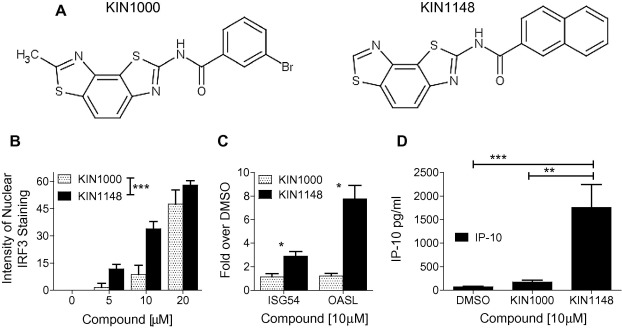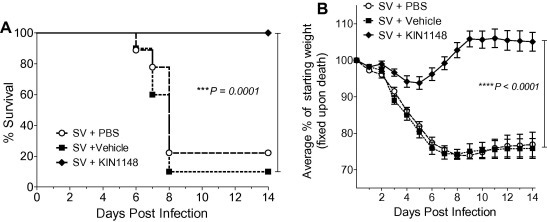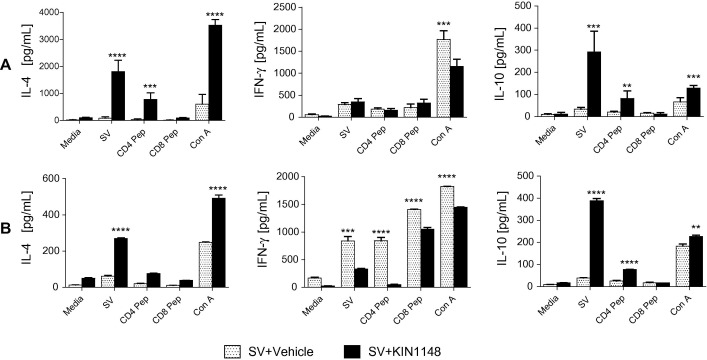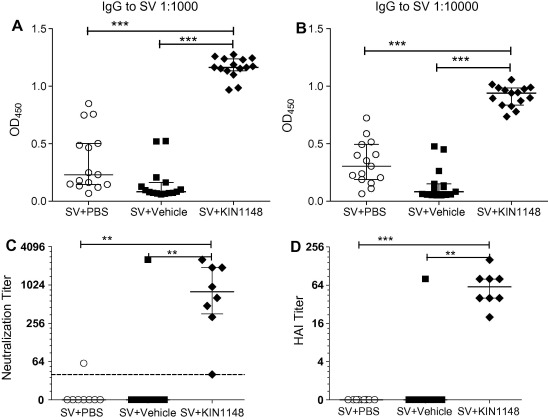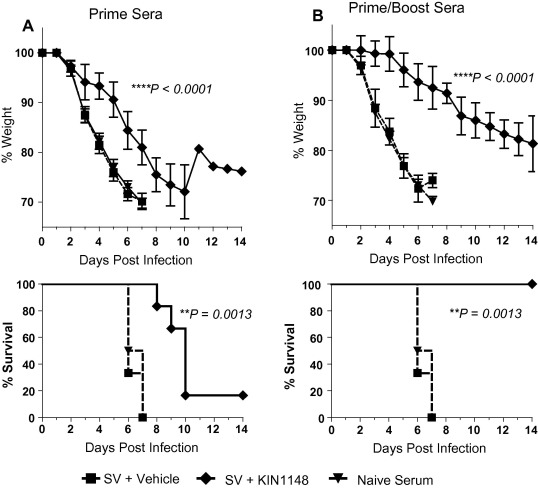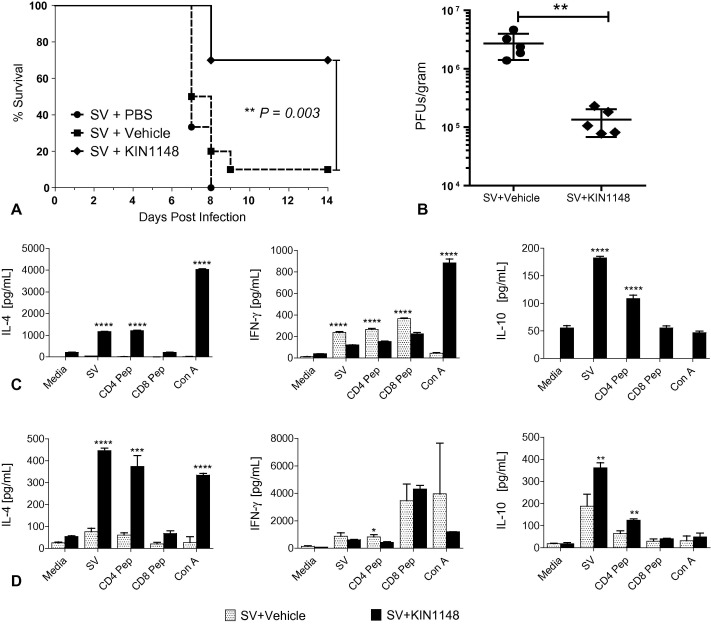This product is for research use only, not for human use. We do not sell to patients.
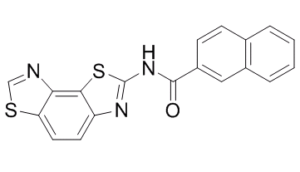
| Size | Price | Stock |
|---|---|---|
| 100mg | $2060 | In Stock |
| 250mg | $3098 | In Stock |
| 500mg | $4640 | In Stock |
Cat #: V3003 CAS #: 1428729-56-9 Purity ≥ 98%
Description: KIN1148 is a small-molecule agonist of the IRF3 (RIG-I-like receptor) pathway and a novel adjuvant therapy of influenza vaccine that is able to enhance the efficacy of flu vaccine. It induces the dose-dependent nuclear translocation of IRF3 in PH5CH8 cells and specific activation of IRF3- responsive promoters. KIN1148 also elicits greater induction of endogenous IRF3-dependent ISG54 and OASL expression by PH5CH8 cells. KIN1148. KIN1148 induced dose-dependent IRF3 nuclear translocation and specific activation of IRF3-responsive promoters. Prime-boost immunization of mice with a suboptimal dose of a monovalent pandemic influenza split virus H1N1 A/California/07/2009 vaccine plus KIN1148 protected against a lethal challenge with mouse-adapted influenza virus (A/California/04/2009) and induced an influenza virus-specific IL-10 and Th2 response by T cells derived from lung and lung-draining lymph nodes. Prime-boost immunization with vaccine plus KIN1148, but not prime immunization alone, induced antibodies capable of inhibiting influenza virus hemagglutinin and neutralizing viral infectivity. Nevertheless, a single immunization with vaccine plus KIN1148 provided increased protection over vaccine alone and reduced viral load in the lungs after challenge. These findings suggest that protection was at least partially mediated by a cellular immune component and that the induction of Th2 and immunoregulatory cytokines by a KIN1148-adjuvanted vaccine may be particularly beneficial for ameliorating the immunopathogenesis that is associated with influenza viruses.
Publications Citing InvivoChem Products
Product Promise

- Physicochemical and Storage Information
- Protocol
- Related Biological Data
- Stock Solution Preparation
- Quality Control Documentation
| Molecular Weight (MW) | 361.44 |
|---|---|
| Molecular Formula | C19H11N3OS2 |
| CAS No. | 1428729-56-9 |
| Storage | -20℃ for 3 years in powder formr |
| -80℃ for 2 years in solvent | |
| Solubility In Vitro | DMSO: ≥100 mg/mLr |
| Water: <1 mg/mLr | |
| Ethanol: <1 mg/mL | |
| SMILES Code | O=C(NC1=NC2=CC=C(SC=N3)C3=C2S1)C4=CC=C5C=CC=CC5=C4 |
| Synonyms | KIN 1148; KIN1148; KIN-1148; Chemical Name: N-(benzo[1,2-d:3,4-d']bis(thiazole)-2-yl)-2-naphthamide |
| Protocol | In Vitro | In vitro activity: KIN1148 is a small-molecule agonist of the IRF3 (RIG-I-like receptor) pathway and a novel influenza vaccine adjuvant found to enhance flu vaccine efficacy. It induces the dose-dependent nuclear translocation of IRF3 in PH5CH8 cells and specific activation of IRF3- responsive promoters. KIN1148 also elicits greater induction of endogenous IRF3-dependent ISG54 and OASL expression by PH5CH8 cells. KIN1148. KIN1148 induced dose-dependent IRF3 nuclear translocation and specific activation of IRF3-responsive promoters. Prime-boost immunization of mice with a suboptimal dose of a monovalent pandemic influenza split virus H1N1 A/California/07/2009 vaccine plus KIN1148 protected against a lethal challenge with mouse-adapted influenza virus (A/California/04/2009) and induced an influenza virus-specific IL-10 and Th2 response by T cells derived from lung and lung-draining lymph nodes. Prime-boost immunization with vaccine plus KIN1148, but not prime immunization alone, induced antibodies capable of inhibiting influenza virus hemagglutinin and neutralizing viral infectivity. Nevertheless, a single immunization with vaccine plus KIN1148 provided increased protection over vaccine alone and reduced viral load in the lungs after challenge. These findings suggest that protection was at least partially mediated by a cellular immune component and that the induction of Th2 and immunoregulatory cytokines by a KIN1148-adjuvanted vaccine may be particularly beneficial for ameliorating the immunopathogenesis that is associated with influenza viruses. KIN1148 induces the dose-dependent nuclear translocation of IRF3 in PH5CH8 cells and specific activation of IRF3- responsive promoters. KIN1148 also elicits greater induction of endogenous IRF3-dependent ISG54 and OASL expression by PH5CH8 cells Kinase Assay: KIN1148 is a small-molecule agonist of the IRF3 (RIG-I-like receptor) pathway and a novel influenza vaccine adjuvant found to enhance flu vaccine efficacy. It induces the dose-dependent nuclear translocation of IRF3 in PH5CH8 cells and specific activation of IRF3- responsive promoters. KIN1148 also elicits greater induction of endogenous IRF3-dependent ISG54 and OASL expression by PH5CH8 cells. KIN1148. Cell Assay: KIN1148 induces the dose-dependent nuclear translocation of IRF3 in PH5CH8 cells and specific activation of IRF3- responsive promoters. KIN1148 also elicits greater induction of endogenous IRF3-dependent ISG54 and OASL expression by PH5CH8 cells. |
|---|---|---|
| In Vivo | Prime-boost immunization of mice with a suboptimal dose of a monovalent pandemic influenza split virus H1N1 A/California/07/2009 vaccine plus KIN1148 protect against a lethal challenge with mouse-adapted influenza virus (A/California/04/2009) and induce an influenza virusspecific IL-10 and Th2 response by T cells derived from lung and lung-draining lymph nodes. Primeboost immunization with vaccine plus KIN1148, but not prime immunization alone, induce antibodies capable of inhibiting influenza virus hemagglutinin and neutralizing viral infectivity. Nevertheless, a single immunization with vaccine plus KIN1148 provide increased protection over vaccine alone and reduce viral load in the lungs after challenge | |
| Animal model | Mice |
| Solvent volume to be added | Mass (the weight of a compound) | |||
|---|---|---|---|---|
| Mother liquor concentration | 1mg | 5mg | 10mg | 20mg |
| 1mM | 2.7667 mL | 13.8336 mL | 27.6671 mL | 55.3342 mL |
| 5mM | 0.5533 mL | 2.7667 mL | 5.5334 mL | 11.0668 mL |
| 10mM | 0.2767 mL | 1.3834 mL | 2.7667 mL | 5.5334 mL |
| 20mM | 0.1383 mL | 0.6917 mL | 1.3834 mL | 2.7667 mL |
This equation is commonly abbreviated as: C1 V1 = C2 V2
- (1) Please be sure that the solution is clear before the addition of next solvent. Dissolution methods like vortex, ultrasound or warming and heat may be used to aid dissolving.
- (2) Be sure to add the solvent(s) in order.





































